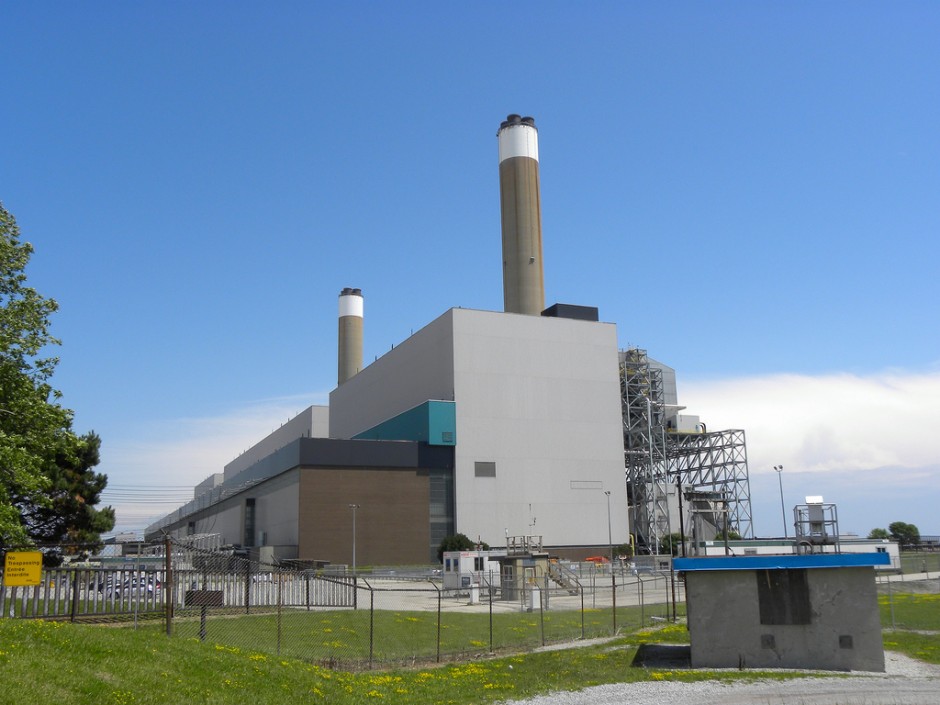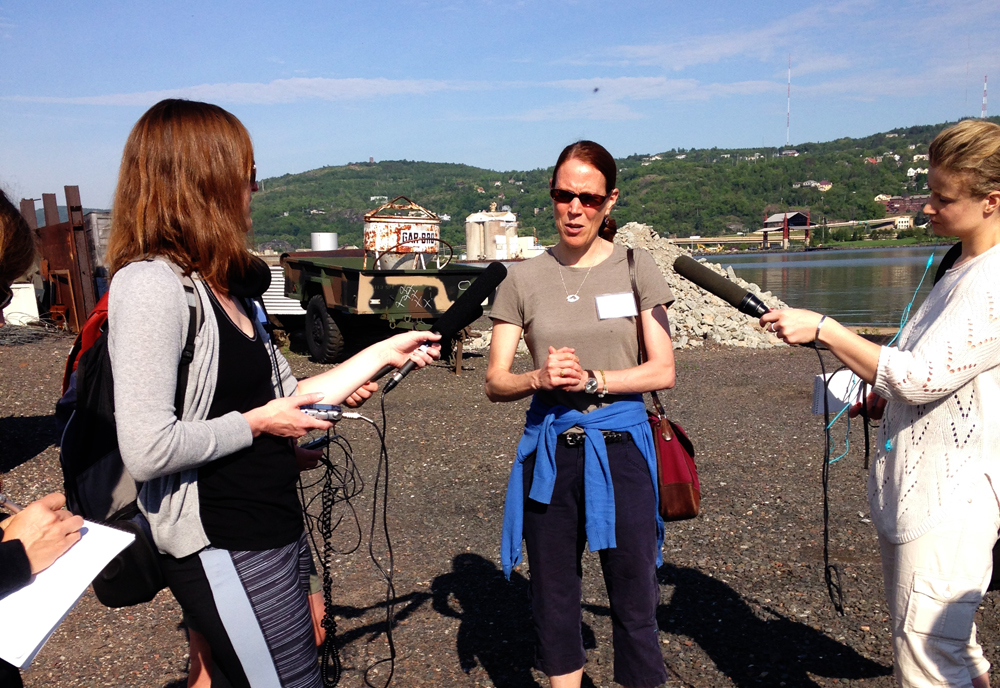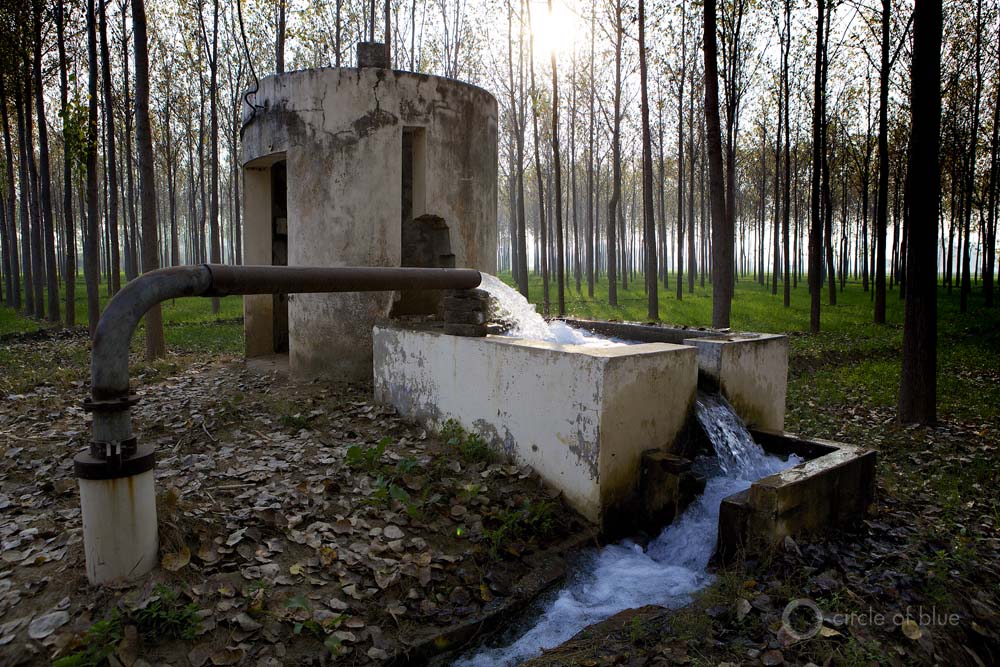In Ending Coal-fired Electricity, Ontario Cuts Water Use and Climate-changing Gases
Canada province pursues a new energy production path.

The Greenfield Energy Center in Courtright, Ontario, is a 422-megawatt natural gas fired power plant completed in 2008. Photo courtesy of jon_lin via Flickr.
A decade ago, Ontario’s coal-fired power plants were responsible for the province’s largest water withdrawals, accounting for 1.8 billion cubic meters (475 billion gallons) of water taken annually for cooling and steam generation from rivers and Lake Ontario. The province’s coal-fired plants were built with once-through cooling systems, meaning that, after passing through the plants, most of that moisture was returned to the environment as hot water.
Next year, though, Canada’s most populous and industrialized province is scheduled to complete a 21st-century environmental clean-up project that distinguishes it among North American jurisdictions.
After a decade of work by the Liberal Party government, Ontario is scheduled to close the last of its big coal-fired generators at the end of this year, leaving a single small coal-fired unit available during periods of peak electrical demand until it closes next year. In shutting down the province’s 19 boilers fueled by coal, Ontario will no longer need fresh water to operate a coal-fired generating sector that provided one-quarter of its electricity, and the province will become the first industrial region on the continent to eliminate coal-fired generation.
Last week, Yale Environment 360 published my in-depth account of Ontario’s program to get out of the coal-fired business — and the environmental and political consequences of this move.
In Ontario, 17 new natural gas-fired generating stations have been built and, with 10 gigawatts of capacity, have replaced the generating capacity that came from coal. According to the U.S. Environmental Protection Agency, natural gas-fired electrical plants produce half the carbon emissions of a coal-fired plant per megawatt-hour, 35 percent less nitrogen oxide, virtually no sulfur dioxide, and no mercury emissions. A study by Sandia National Laboratories, a U.S. Department of Energy research center, found that natural gas-fired plants consume 60 percent less water than coal-fired plants per megawatt-hour.
Getting Out of the Coal Business
Ending Ontario’s reliance on coal-fired power is the latest step in a long program of environmental progress in that province. Over the last half-century, Canada’s wealthiest province required and enforced cities and industries to treat every gallon of wastewater, dramatically reduced the level of sulfur and other pollutants that caused acid rain, and convinced the big and politically powerful pulp and paper industry to install state-of-the-art emissions control equipment.
“I’ve encouraged Americans to look across the border and learn something.”
–Paul Gipe
Energy industry analyst
The decade-long process to replace coal-fired generating capacity with new plants fueled by natural gas and renewable energy sources represents one of the most ambitious low-carbon generating strategies in the world. Achieving the coal-less electricity sector also yielded lessons about the constraints of public policy and civic acceptance in an industrial democracy seeking to make such a momentous transition.
“What Ontario has done is impressive,” said Tim Weis, the director of renewable energy policy at the Pembina Institute, one of Canada’s most respected environmental research organizations. “But it’s also caused a lot of resistance and not just from the people you’d expect. The government overcame the struggles to some extent. It does illustrate what is possible and what to anticipate in terms of getting off of coal.”
Weaning economies off of coal, as Ontario learned, is no small feat. In 2003, Ontario had more than 7.5 gigawatts of coal-fired generating capacity, which produced one-quarter of its power supply. Ontario’s coal consumption peaked that year at 18.6 million metric tons. Coal-fired power plants were Ontario’s largest source of toxic chemical, heavy metal, sulfur, and nitrogen air pollution. Carbon emissions from coal-fired generation rose to more than 41 million metric tons annually.
Politics of Shutting Down
The program to end Ontario’s reliance on coal began that same year with an exceptional debate about energy that helped decide the election for provincial premier. Liberal candidate Dalton McGuinty and Conservative incumbent Premier Ernie Eves challenged each other on how quickly to shut coal-fired plants.
Smog, dust, and mercury emissions worried Eves, who said he could do it by 2015. McGuinty shot back that he could push Ontario out of the coal-generated electricity business by 2007, a message of energy conservation and efficiency that helped propel him to victory. Soon after McGuinty’s election, the provincial government began the process of closing coal plants.
In 2005, the 1.13-gigawatt Lakeview coal-fired plant in Toronto, one of the province’s oldest, was shut down. In 2009, four generating units at a plant in Nanticoke and two units at another plant in Lambton were shut. A year later, two more units at Nanticoke were closed. Last year, a small plant in Atikokan closed.
“What Ontario has done is impressive. But it’s also caused a lot of resistance and not just from the people you’d expect.”
–Tim Weis
Pembina Institute
This year, the last generating units in Nanticoke and Lambton will close, and a separate plant in Atikokan is being converted to burn wood pellets. Coal consumption, coal-fired generating capacity, and emissions of mercury, other toxic compounds, and carbon dioxide from coal-fired plants will fall to near zero, according to the Ontario Environment Ministry.
The final two coal-fired generators, at a 300-megawatt plant in Thunder Bay, will cease burning coal next year, according to Neal Kelly, the spokesman for Ontario Power Generation, the provincial utility.
“The 2007 deadline was ambitious,” said Garry McKeever, director of energy supply in the Ontario Ministry of Energy. “When the new government got into office, it ran up against the mechanics of how to get this done. Communities worried about job losses. Industries worried about having enough power. It takes time to build replacement generation.”
According to the Ministry of the Environment, from 2000 to 2010, air quality improved province-wide in Ontario, and the phasing-out of coal plants was a key reason. Ontario also implemented programs to reduce emissions from smelting plants and reduce particulates and toxic air contaminants from the transport sector.
Overall, the electrical sector’s nitrogen oxide emissions dropped from 110,000 metric tons in 2000 to 55,000 metric tons in 2010, and mean nitrogen oxide concentrations in the air dropped from 21 parts per billion (ppb) in 2003 to 12.5 ppb in 2010. Similar cuts were realized for sulfur dioxide emissions. The number of smog advisory days dropped from 27 in 2002 to just three in 2010. Particulate concentrations in the province’s air fell from 8.1 micrograms per cubic meter in 2003 to 4.8 micrograms per cubic meter in 2010, a 40 percent decline.

The Nanticoke coal-fired power plant in Ontario, on the shores of Lake Erie, is one the largest such facilities in North America. Ontario’s government decided to close the plant by the end of 2013. Photo courtesy of JasonParis via Flickr Creative Commons
The economic effects of the closures varied from town to town. For instance a coal-fired plant in Sarnia, an industrial city in southern Ontario along the border with Michigan, was replaced by a new plant, fueled by natural gas, that is currently under construction. And Ontario Power Generation responded to its own staff resistance by promising severance payments, or jobs in the utility’s 65 hydro and three big nuclear plants for workers who were willing to transfer.
The transition away from coal also was helped by political and economic circumstances. Unlike the United States — where miners, producers, truckers, railroads, and utilities form strong regional coal alliances — coal-fired power in Ontario had no other influential political constituencies.
Most of the coal-fired generators also closed as the American economic meltdown engulfed Ontario’s auto manufacturing sector, North America’s largest producer of vehicles and parts, and one of Ontario’s biggest power consumers. The continuing slump in the pulp and paper industry also lowered demand for power. Consumption of electricity fell from 150,000 gigawatt-hours in 2008 to 140,000 gigawatt-hours in 2009.
In a power system with more than 35 gigawatts of generating capacity, Ontario’s three big nuclear plants alone account for almost 13 gigawatts of generating capacity and 56 percent of the province’s electrical power. (Hydropower, with almost 8 gigawatts of capacity, generates 22 percent of the electricity.)
Renewables Moving In
The province’s ample electricity supply, and the closing of coal-fired generators, carved political space for Premier McGuinty and his staff to propose generating new jobs in energy innovation and manufacturing with home-grown renewable technology. In 2009, the province enacted the Green Energy Act to promote renewable sources. It included feed-in tariff provisions, modeled after similar programs in Denmark and Germany, that offered 20-year contracts for utilities to purchase wind-, solar-, biomass-, and biogas-fueled electricity from producers at generous prices.
The new statute and its revenue provisions spurred a rush of big wind farms. Hundreds of windmills, for instance, were built on farmland along the highway corridor from Windsor to Toronto. Wind generating capacity now measures 2 gigawatts — or six percent of the total generating capacity — which will double in the next 18 months, said the Energy Ministry. The Liberal government estimates that 30,000 jobs are connected to the government’s green energy policies.
“It’s a good story to tell and a lot of people haven’t heard it,” said Paul Gipe, an energy industry analyst from California who worked with Ontario citizen groups to replace coal with renewable energy. “I’ve encouraged Americans to look across the border and learn something.”
Wind Woes
Both gas and wind, though, have prompted civic dissent. Citizen opposition forced the cancellation of gas-fired plants in Oakville and Mississauga, two suburbs of Toronto. And wind farms have attracted opposition in rural areas.
The discord over wind, said Tom Adams, an energy consultant in Toronto and author of tomadamsenergy.com, a blog, is driven in part by a provision in the 2009 Green Energy Act that removed the authority of local governments to review and approve land use permits for wind projects.
“People began to feel like their rights were taken away,” said Adams.
Opposition groups formed to stop projects. Ontario issued a formal moratorium for offshore wind development in Lake Ontario. Citizen groups filed lawsuits to halt projects, many of them motivated by fears that projects would reduce property values.
Wind energy development is also being blamed for rising electricity prices in Ontario. Paul Gipe responds that wind development — which accounted for less than four percent of all electricity generated last year – isn’t big enough to dramatically affect power prices.
Other factors also are in play, said Garry McKeever of the Energy Ministry, including the cost of expanding and modernizing the province’s transmission grid and refurbishing the province’s big nuclear generating sector.
“The current Liberal government has heard the opposition,” said McKeever, “and is working to address the concerns of municipalities, and restoring some of those authorities. It’s been a learning process of this government. We can respond. That is the spirit of this government.”
Circle of Blue’s senior editor and chief correspondent based in Traverse City, Michigan. He has reported on the contest for energy, food, and water in the era of climate change from six continents. Contact
Keith Schneider










Yes and in the process drove electricity rates so high that industry has left the province in droves and we are now a “have not” province that must now take transfer payments from Canadas richer provinces. The first time since confederation that Ontario receives money to keep it afloat. The scary thing is the provincial government is racking up huge debt to keep the true cost of power hidden from the people but hey, even though we’re broke and our healthcare is now in danger of being scaled back, we can take solace in the fact that we had 20 less smog days last year, a big price to pay for a small gain.